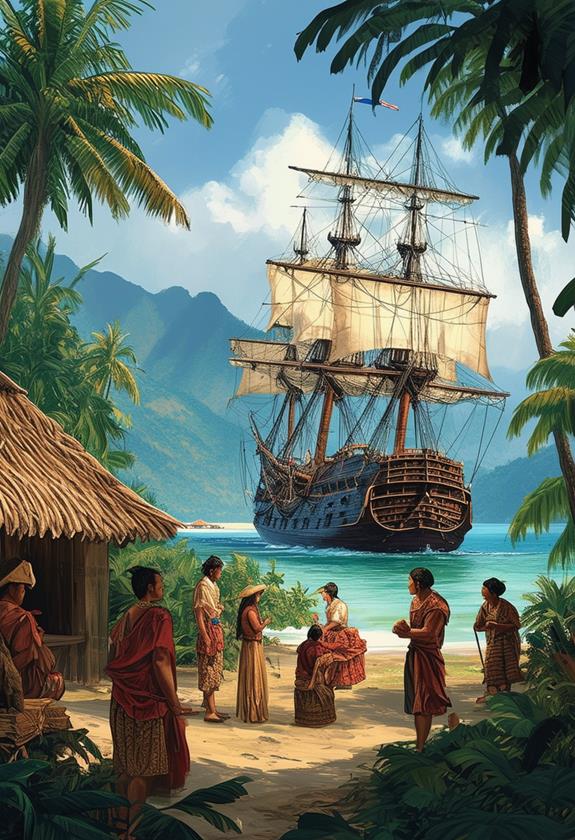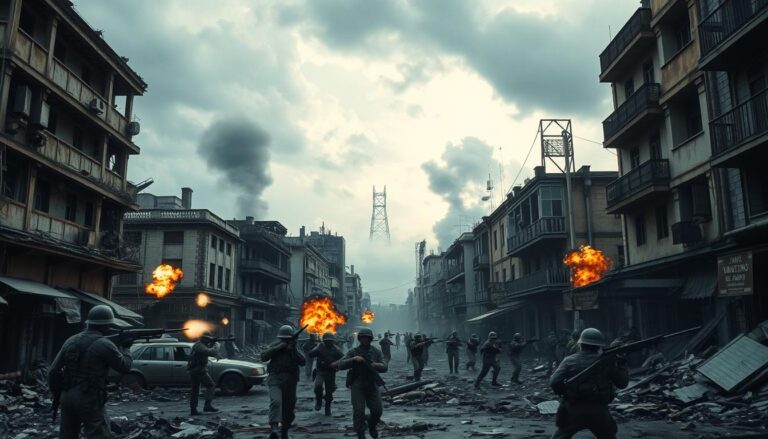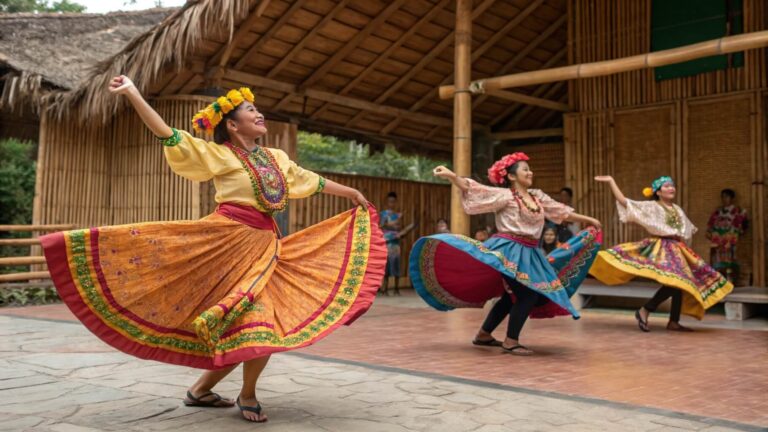Spanish Colonization of the Philippines: A Historical Overview

When the Spanish arrived in the Philippines in 1521, led by Ferdinand Magellan, they initiated over three centuries of colonization that transformed the archipelago. You'd find that by 1565, they'd established a structured colonial government, which drastically altered local societies through land redistribution and the integration of new agricultural practices. This era also marked the beginning of significant cultural and religious syncretism, blending Catholic and native beliefs which are still evident in modern festivals like *Sinulog* and *Pahiyas*. If you're intrigued by how these changes have shaped contemporary Filipino society, you'll find the legacy of this period deeply fascinating.
Highlights
- Ferdinand Magellan initiated Spanish influence in the Philippines by arriving in 1521, leading to over three centuries of Spanish rule.
- The establishment of a structured colonial administration in 1565 allowed for the enforcement of Spanish decrees and land redistribution.
- Economic transformations included the introduction of new crops and the encomienda system, integrating the Philippines into global trade networks via the Manila galleons.
- Cultural and religious integration saw the blending of indigenous practices with Catholic doctrines, influencing local traditions and festivals.
- Resistance against Spanish rule was marked by numerous revolts, including the Dagohoy Rebellion and the Cry of Pugad Lawin, showcasing enduring Filipino spirit.
Arrival of Ferdinand Magellan
In 1521, Ferdinand Magellan's fleet reached the shores of the Philippine archipelago, marking the beginning of Spanish influence in the region. Magellan's expedition wasn't just a voyage; it was a monumental navigation challenge that tested the limits of 16th-century seafaring technology and human endurance.
As you imagine steering through uncharted waters, think about the vast Pacific Ocean's intimidating expanse, fraught with unpredictable weather and unknown hazards. Navigating these waters required expert knowledge of the stars and a good deal of luck.
Magellan's crew had to contend with limited maps and navigational tools that were rudimentary at best. They relied heavily on dead reckoning—a method where you estimate your current position based on a previously determined location, which is as tricky as it sounds. The constant threat of scurvy and other diseases added to their woes, making every day a gamble against nature's unpredictability.
Despite these challenges, Magellan's arrival in the Philippines opened up new routes for trade and colonization, reshaping global commerce and geopolitics.
It's fascinating to think how this expedition's success hinged on overcoming extreme navigational challenges, forever altering the course of history.
Establishment of Spanish Rule
After Magellan's pivotal arrival, the Spanish quickly moved to consolidate their power, establishing a colonial government in the Philippines by 1565. You'd notice that this wasn't a mere flag-planting venture. The Spanish, driven by strategic and economic motives, wasted no time setting up a structured colonial administration. This was a clear shift from exploration to full-on governance.
Under this new administration, a complex system unfolded. They appointed officials who'd oversee the various regions, ensuring that Spanish decrees were enforced uniformly across the islands.
But it wasn't just about ruling; it was about owning. Land redistribution became a tool for both control and reward. Large tracts of land, previously under local chieftains, now shifted hands to Spanish landlords and military officials. This reorganization wasn't just administrative paperwork; it reshaped the very landscape of Filipino society.
As you can imagine, these moves brewed tension and resistance among the locals. Yet, the Spanish held firm, establishing a rule that would last for more than three centuries.
You're now seeing how deep the roots of colonial influence went, setting the stage for a complex historical legacy that's still evident in modern-day Philippines.
Cultural and Religious Integration
Shaping the very soul of the Philippines, Spanish colonization deeply intertwined cultural and religious practices with local traditions. As you explore this rich historical fabric, you'll find that cultural assimilation wasn't just a policy but a lived experience.
Streets buzzed with the sounds of church bells and the calls of market vendors, selling both local and Spanish goods. This mingling of lifestyles was complemented by religious syncretism, where pre-colonial spiritual beliefs were woven seamlessly with Catholic doctrines.
Imagine attending a festival in colonial Philippines. You'd witness indigenous dances performed alongside Spanish folk music, a vivid illustration of cultural blending. Religious events especially highlighted this syncretism. The traditional animist practices of the natives were often integrated into the Catholic rituals introduced by the Spaniards. This wasn't merely a fusion of religious practices but also a strategic move by the colonizers to embed their influence more deeply.
You see, the integration wasn't always harmonious. Tensions flared as traditional leaders grappled with the new European ways.
However, over time, a unique Filipino culture emerged, one that resonated with both ancestral spirits and saintly devotions. This blend is what you now recognize as distinctly Filipino, a reflection of centuries of cultural and religious integration.
Key Figures in Colonization
Exploring the cultural and religious fabric of the Philippines brings us to the individuals who played pivotal roles in its colonization. Among the key explorers, Fernando de Magallanes, better known as Ferdinand Magellan, stands out.
You've probably heard how he led the first expedition to circumnavigate the globe, inadvertently arriving in the Philippines in 1521. While his journey ended there, it marked the beginning of significant Spanish interest in the archipelago.
Following Magellan, Miguel López de Legazpi took up the mantle, establishing the first permanent Spanish settlement in Cebu in 1565. His adept handling of both local alliances and conflicts laid the groundwork for the colonial administration that would govern the islands for centuries.
Legazpi's tenure as governor set the administrative patterns and policies, influencing the complex interplay of cultural and military efforts that characterized Spanish rule.
These figures weren't just explorers; they were also administrators, shaping the political landscape of the Philippines through their decisions and interactions with native populations.
Their legacies, a blend of exploration and governance, demonstrate how the tendrils of empire were as much about the people in power as the policies they implemented.
Resistance and Revolts
You may find it unsurprising that the heavy hand of Spanish colonization sparked numerous revolts across the Philippines. The imposition of foreign rule stirred a fierce spirit of resistance amongst the diverse native populations, leading to various native uprisings and anti-colonial movements.
These revolts weren't just scattered bursts of anger; they were organized and persistent efforts by Filipinos to reclaim autonomy.
Here's a brief look at some key revolts:
- Dagohoy Rebellion (1744-1829) – This was the longest-lasting revolt in Philippine history, ignited by Francisco Dagohoy's personal grudge against Spanish authorities due to the refusal of a Christian burial for his brother. It evolved into a broader struggle for freedom involving thousands of natives.
- Silang Revolt (1762-1763) – Led by Diego Silang and his wife Gabriela, this movement initially allied with British forces opposing Spain. After Diego's assassination, Gabriela bravely continued the fight against Spanish rule, symbolizing female participation in anti-colonial efforts.
- Cry of Pugad Lawin (1896) – A pivotal moment in Philippine revolutionary history, where Katipunan leaders, led by Andrés Bonifacio, tore up their cedulas (residence certificates) as a symbol of their commitment to fight Spanish oppression.
These uprisings are proofs of the enduring Filipino spirit confronting colonial domination.
Economic Transformations
While the Spanish colonization brought numerous challenges, it also catalyzed profound economic transformations across the Philippines. You'd see these changes prominently through the introduction of new agricultural techniques and crops. Imagine fields that once grew only local staples now bursting with maize, tobacco, and even pineapples from the Americas.
These agricultural changes weren't just about new crops; they reshaped the entire economy. The Spanish imposed the encomienda system, assigning land and local labor to colonizers. This shift not only changed what was grown but also how it was cultivated, moving towards a more export-oriented agriculture.
Moreover, the Philippines became a crucial part of global trade networks. Previously isolated from the massive trade currents, you now had Manila galleons traversing the Pacific, connecting Asia with the Americas.
This new role brought you into direct contact with vast markets and introduced a wealth of foreign goods, which in turn influenced local economies profoundly. Silver from the Americas exchanged for your silks and spices, weaving the islands into the fabric of global commerce.
This integration marked a significant pivot in your economic landscape, setting the stage for further changes and challenges in the centuries to follow.
Legacy of Spanish Influence
The legacy of Spanish influence in the Philippines extends far beyond the centuries of colonization. You'll find traces of Spain not only in the cobblestone streets of Vigan but also in the vivid celebrations and rich flavors of everyday life. Here's how:
1. Language and Communication: Spanish colonization left an indelible mark on Filipino languages. While Filipino and English are the official languages, Spanish has influenced over 4,000 Filipino words.
This linguistic blend is a reflection of language preservation, keeping alive the echoes of the past in modern speech.
2. Culinary Fusion: Your taste buds can't miss the Spanish impact when you enjoy Filipino cuisine. From the hearty *adobo* to the festive *lechon*, these dishes blend Spanish flavors with local ingredients, creating a unique culinary fusion beloved across the islands.
3. Cultural and Religious Practices: Spanish colonial rule greatly shaped Filipino culture, particularly in religious practices. Festivals like *Sinulog* and *Pahiyas* reflect this, where indigenous and Catholic traditions intertwine, illustrating a shared heritage that continues to flourish.
Each of these elements weaves a rich fabric of history that you're part of every day, a blend of past and present that shapes the Filipino identity.
Frequently Asked Questions
How Did Spanish Colonization Impact Indigenous Filipino Gender Roles?
You'll find that Spanish colonization reshaped indigenous Filipino gender dynamics, enforcing colonial patriarchy. This shift disrupted traditional roles, placing more constraints on women's social, political, and economic participation in their communities.
What Was the Role of Chinese Merchants During Spanish Colonization?
You'd find Chinese merchants were essential, facilitating trade networks and cultural exchange during the Spanish colonization. They bridged local and foreign economies, greatly influencing the commercial landscape of the Philippines.
How Did Spanish Colonization Affect Philippine Biodiversity?
Spanish colonization led to significant biodiversity loss in the Philippines. You'd see introduced species and habitat changes, drastically impacting native flora and fauna amidst cultural exchanges that altered local ecological landscapes.
Were There Filipino Collaborators With Spanish Colonizers?
Yes, there were Filipino collaborators. Elite groups formed political alliances and engaged in cultural assimilation, partly due to economic motivations. They helped maintain Spanish rule in exchange for certain privileges and power.
Did Any Other European Powers Challenge Spain in the Philippines?
Yes, other European powers challenged Spain in the Philippines. The Dutch invasion and the British occupation are key examples. They sought to weaken Spain's control and expand their own colonial influence in Asia.
Final Thoughts
In wrapping up, you've seen how Spanish colonization shaped the Philippines over centuries, blending cultures and sparking both cooperation and conflict. Figures like Magellan and local leaders played pivotal roles, while widespread changes in religion, economy, and society left a lasting impact. Resistance movements and revolts highlighted the Filipinos' struggle for autonomy. Today, the legacy of this era is evident in the country's language, traditions, and religious beliefs, underscoring a complex but enduring influence on Filipino identity.






